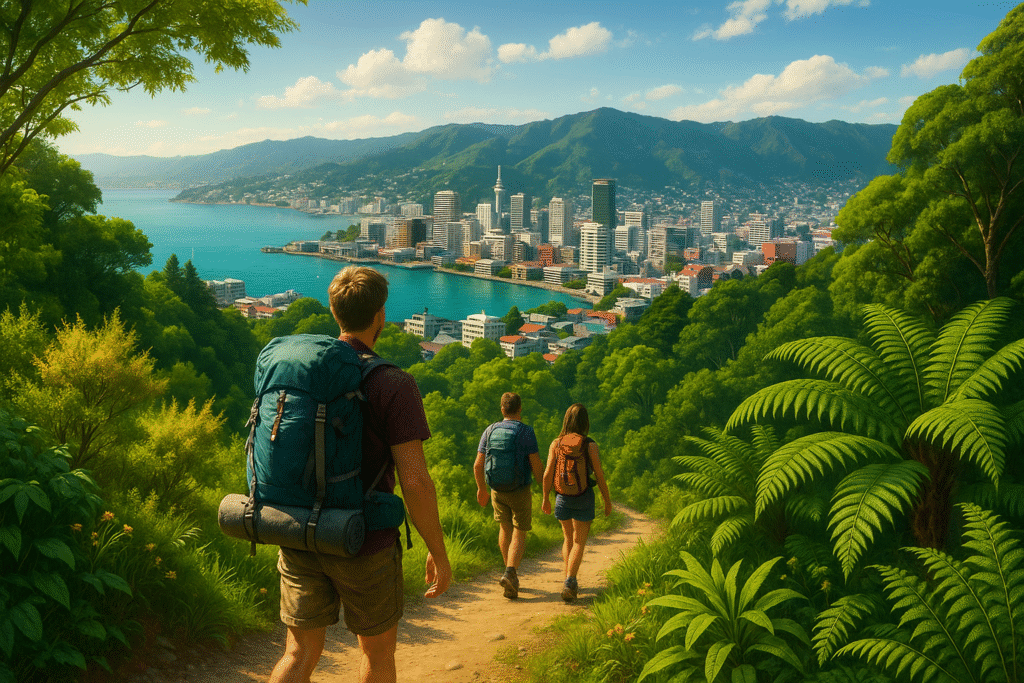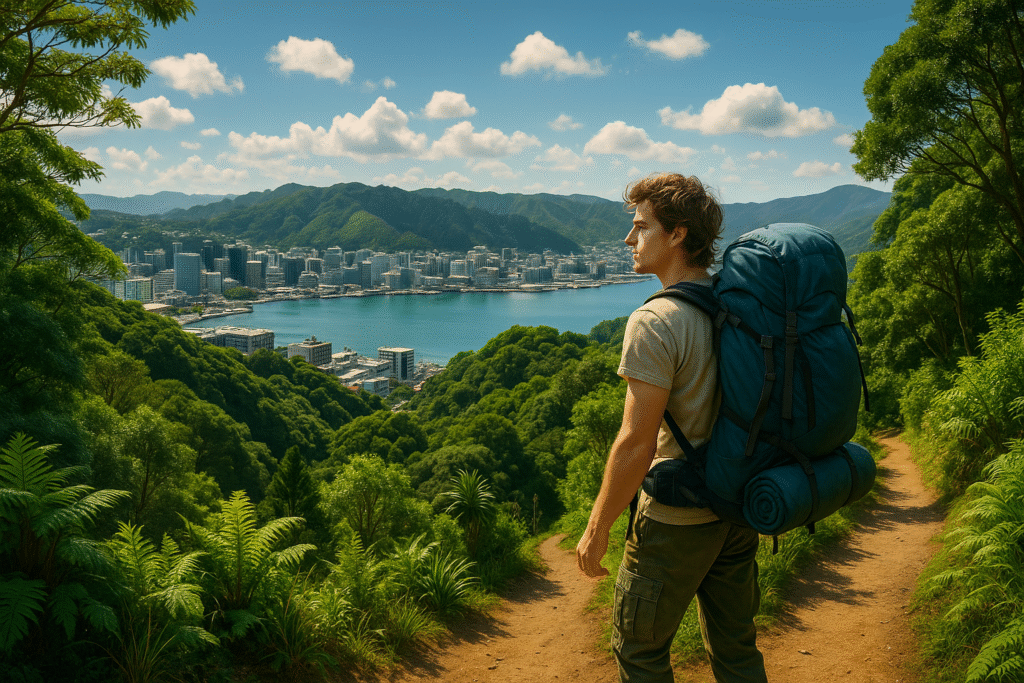Table of Contents

Introduction to New Zealand’s Natural Beauty
New Zealand is renowned for its extraordinary natural beauty, making it a prime destination for nature lovers and outdoor enthusiasts. The country’s unique geographical features offer an incredible variety of landscapes, from rugged mountains and serene beaches to lush rainforests and sprawling plains. Each of these diverse ecosystems provides a backdrop for adventure and exploration, drawing visitors to experience the wonders of the great outdoors.
The North Island features geothermal wonders, vibrant Maori culture, and the stunning coastline of the Bay of Islands, where turquoise waters meet golden sands. In contrast, the South Island boasts the majestic Southern Alps, home to Aoraki/Mount Cook, the highest peak in New Zealand. These magnificent mountains are interspersed with pristine lakes, such as Lake Wanaka and Lake Te Anau, which reflect the breathtaking scenery surrounding them.
New Zealand’s national parks, such as Fiordland and Abel Tasman, are perfect for backpackers seeking immersive experiences in nature. The rugged trails and well-maintained pathways allow adventurers to explore remote areas, witness breathtaking vistas, and appreciate the endemic flora and fauna. One can find the famous Milford Track and Routeburn Track in Fiordland, which are recognized globally for their stunning landscapes and captivating scenery.
In addition to its dramatic mountain ranges and scenic fjords, New Zealand is home to diverse wildlife, including unique species such as the kiwi bird and the Hector’s dolphin. The abundance of natural beauty, paired with the rich Maori heritage, adds layers of depth and intrigue to the backpacking experience. This natural richness makes New Zealand an essential destination for those who seek to immerse themselves in the outdoors, exploring its beauty one trail at a time.
Planning Your Backpacking Adventure
Embarking on a backpacking adventure through New Zealand is an exhilarating experience, but careful planning can significantly enhance the journey. The first step in organizing your trip is to decide on the best time to visit. The Southern Hemisphere’s summer months, from December to February, offer the warmest weather, making it ideal for trekking and exploring the great outdoors. Conversely, traveling during the shoulder seasons of spring (September to November) and autumn (March to May) can result in fewer crowds and breathtaking scenery, with wildflowers blooming or leaves changing color.
Once the timing is established, selecting the right routes is crucial. New Zealand boasts a plethora of stunning trails, ranging from the famous Tongariro Alpine Crossing to the breathtaking Routeburn Track. Consider the landscape you wish to explore; for instance, the North Island features volcanic landscapes and lush greenery, while the South Island showcases dramatic fjords and snow-capped mountains. Researching each trail’s difficulty and duration is important to match your fitness level and timeframe.
Budget considerations should also be at the forefront of your planning process. Accommodation options vary widely, from camping grounds to backpacker hostels and holiday parks. Factor in the cost of food, transport, and additional activities such as guided tours or bungee jumping. Utilizing public transport, such as buses and shuttles, can often be economical choices for navigating between major hiking locations.
For itinerary suggestions, consider a loop starting in Auckland, proceeding through Rotorua, Queenstown, and Christchurch. This route highlights the volcanic landscapes, geothermal parks, and pristine lakes, providing an excellent overview of New Zealand’s natural beauty. Tailoring your backpacking itinerary to include both popular attractions and off-the-beaten-path destinations will offer a well-rounded experience, ultimately making your trip memorable and fulfilling.
Essential Gear and Packing Tips
Backpacking through New Zealand is an exhilarating experience for nature enthusiasts, but it requires careful planning and packing to ensure a safe and enjoyable journey. Essential gear plays a critical role in the comfort and safety of backpackers as they traverse diverse landscapes. Selecting the right clothing is vital; breathable, moisture-wicking layers help regulate temperature, while waterproof jackets are essential for unpredictable weather. Durable hiking boots are indispensable, providing necessary support and grip on various terrains.
Camping equipment is another crucial aspect of preparation. A lightweight, compact tent can protect you from the elements and provide a comfortable sleeping environment. Consider investing in a sleeping bag rated for the temperatures you may encounter, as nights in the New Zealand wilderness can be surprisingly chilly. A portable stove, along with lightweight cooking supplies such as pots, utensils, and food containers, will enable you to prepare hot meals, which are a welcome treat after a long day of hiking.
Safety items should not be overlooked while packing. A first-aid kit is essential for addressing minor injuries and keeping your adventure stress-free. Additionally, carrying a multi-tool can prove helpful for various tasks, from food preparation to fixing gear. Navigation tools—such as a GPS device or a reliable map—are vital for safely exploring New Zealand’s expansive natural areas.
When it comes to packing efficiently, aim to travel light without compromising necessities. Packing in layers can maximize space, and using packing cubes can help keep your gear organized. Prioritize lightweight and multi-functional items to minimize weight, especially for longer treks. Lastly, always remember to leave room for the natural treasures you will collect along your journey, ensuring that your backpack remains manageable yet ready for adventure.
Exploring the North Island: Nature Hotspots
New Zealand‘s North Island is a treasure trove of natural wonders, offering pristine landscapes and diverse ecosystems that captivate nature lovers from around the globe. Among the prominent locations is **Tongariro National Park**, a UNESCO World Heritage site characterized by its volcanic terrain and stunning hiking trails. The **Tongariro Alpine Crossing** is particularly famous, providing trekkers with awe-inspiring views of emerald lakes and steaming craters. This hike not only challenges the adventurous spirit but also rewards them with sights of rare flora adapted to the unique volcanic environment.
Another jewel on the North Island is the **Bay of Islands**, an archipelago comprising 144 islands known for their rich marine life and breathtaking scenery. This area is a paradise for kayaking enthusiasts and dolphin watching, as the waters teem with various marine species, including the playful bottlenose dolphin. The secluded beaches and lush island landscapes present a perfect backdrop for exploration, whether one opts for a boat tour or a leisurely hike along the coastline.
Additionally, the **Coromandel Peninsula** is renowned for its stunning beaches and lush forests. The **Cathedral Cove** and **Hot Water Beach** are must-visit sites, where visitors can enjoy the beauty of natural rock formations and indulge in unique geothermal experiences. The region’s hiking trails, such as the **Coromandel Coastal Walkway**, showcase dramatic cliffs and diverse vegetation, making it a favorite for hikers who seek both adventure and tranquility in nature.
Exploring these hotspots reveals the unique flora and fauna found on the North Island, making it a prime destination for those passionate about biodiversity and natural landscapes. Each location offers something distinct, contributing to the rich tapestry of New Zealand’s natural heritage and providing memorable experiences for visitors.
The South Island: A Backpackers Paradise
The South Island of New Zealand stands out as a premier destination for backpackers, offering a wealth of natural beauty and exhilarating outdoor experiences. Renowned for its dramatic landscapes, this region is home to a myriad of iconic locations that attract nature lovers and adventure enthusiasts alike. One of the crown jewels of the South Island is Fiordland National Park, a UNESCO World Heritage site celebrated for its stunning fjords, majestic mountains, and diverse ecosystems.
Within Fiordland, visitors can explore the famous Milford Sound, often regarded as one of the most breathtaking places on Earth. The park provides numerous opportunities for backpacking, with well-maintained trails that allow hikers to immerse themselves in the rich flora and fauna. The landscapes range from lush rainforests to shimmering lakes, creating a picturesque backdrop for any trekking experience.
Another notable destination is Mount Cook National Park, which is home to New Zealand’s highest peak, Aoraki/Mount Cook. The park’s alpine environment is characterized by stunning glaciers, rugged mountain ranges, and pristine alpine lakes. Backpackers can embark on various hiking trails, suitable for different skill levels, showcasing the breathtaking scenery of the Southern Alps. The Hooker Valley Track, in particular, is a popular choice among hikers, offering stunning views of the mountain ranges and glacial rivers along the way.
Lastly, Abel Tasman National Park is renowned for its golden beaches and clear turquoise waters, providing a different kind of backpacking adventure. The coastal track here features opportunities for kayaking, swimming, and relaxing on the beachfront. Backpackers can choose to explore the park’s scenic walking trails, taking in its lush forests and diverse wildlife. Whether one is seeking the thrill of alpine adventures or the tranquility of coastal experiences, the South Island of New Zealand truly embodies a backpacker’s paradise.
Wildlife Encounters on Your Journey
New Zealand, often celebrated for its breathtaking landscapes, is equally renowned for its diverse and unique wildlife. This island nation offers a plethora of opportunities to encounter native species, making it a haven for nature lovers and backpackers alike. Among its most iconic inhabitants are the kiwi and kea, both of which embody the country’s commitment to preserving its natural heritage. The kiwi, a flightless bird and a national symbol, is nocturnal and predominantly found in forests, while the kea, a cheeky alpine parrot known for its curiosity, roams the mountainous regions. Observing these remarkable birds in their natural habitats provides a profound connection to the country’s identity.
In addition to terrestrial fauna, New Zealand’s marine ecosystems are equally captivating. The waters surrounding the islands are home to a rich variety of marine life, which can be explored through activities such as whale watching and swimming with dolphins. Locations like Kaikoura are famous for their whale-watching tours, providing visitors with the chance to observe sperm whales, orcas, and playful dolphins in their natural environments. These immersive experiences not only enrich backpacking adventures but also create lasting memories.
However, as travelers explore these natural wonders, it is vital to prioritize conservation and respect for wildlife habitats. New Zealand’s ecosystem is delicate, and human interaction can significantly impact local species. Tourists are encouraged to partake in responsible travel practices, such as keeping a safe distance from animals, adhering to guidelines provided by wildlife tour operators, and avoiding littering in natural spaces. By fostering an attitude of respect towards wildlife and their habitats, backpackers can contribute to New Zealand’s conservation efforts, ensuring that these natural gems can be enjoyed by future generations.
Sustainable Backpacking Practices
Backpacking through New Zealand offers an opportunity to explore the nation’s breathtaking landscapes while promoting sustainable travel practices. Adopting environmentally responsible habits not only helps to preserve the natural beauty of New Zealand but also fosters positive interactions with local communities. One of the key principles to embrace is the Leave No Trace philosophy, which encourages backpackers to minimize their impact on the environment. This includes staying on established paths, avoiding the picking of native plants, and carrying out all waste, including food scraps and litter.
Furthermore, reducing plastic usage is crucial for maintaining New Zealand’s pristine environments. Backpackers can contribute to this effort by opting for reusable water bottles, containers, and utensils. Purchasing food and goods in bulk rather than single-use packaging significantly decreases plastic waste. Many supermarkets and local markets around New Zealand offer refill stations and bulk goods that align with these sustainable practices. Additionally, it is advisable to choose biodegradable products for toiletries and any gear used during the trip.
Engaging with and supporting local communities is another vital aspect of sustainable backpacking. Choosing locally-owned accommodations, dining in family-run restaurants, and participating in community-run tours allows travelers to contribute economically to these communities. Moreover, many areas in New Zealand have conservation projects that welcome volunteer assistance, providing a unique opportunity for backpackers to contribute directly to the preservation of the beautiful landscapes they explore.
Incorporating these sustainable practices not only enhances the backpacking experience in New Zealand but also reinforces the importance of responsible tourism. By being mindful of our impact, we can enjoy the wondrous nature that New Zealand has to offer while ensuring that future generations can do the same.
Cultural Experiences Along the Way
As backpackers traverse the picturesque landscapes of New Zealand, the rich tapestry of its cultural heritage offers an enriching experience that complements the natural beauty of the country. A significant aspect of this cultural immersion is the opportunity to engage with the Māori community, which is an integral part of New Zealand’s identity. Backpackers can participate in cultural experiences such as attending a traditional pōwhiri (welcome ceremony), where they are greeted with karanga (call), and treated to a performance showcasing haka (war dances) and waiata (songs). These ceremonies not only highlight Māori customs but also foster a deep connection between visitors and the local people.
In addition to personal interactions with the Māori, travelers can explore numerous cultural sites that hold historical significance. For instance, the Waitangi Treaty Grounds is a pivotal location where the Treaty of Waitangi was signed in 1840, marking the beginning of the relationship between Māori and the British Crown. Guided tours at this site provide insightful narratives about New Zealand’s history and the ongoing cultural revitalization efforts by Māori communities across the country.
Participating in local events, such as the Kapa Haka festivals, showcases traditional Māori performing arts and allows backpackers to appreciate the vibrancy of New Zealand’s indigenous culture. Engaging in hands-on workshops, such as weaving or carving, further enhances this experience, as it provides a glimpse into the artistic skills that have been passed down through generations.
Embracing these cultural experiences while journeying through New Zealand not only augments the natural exploration but also fosters a greater understanding and respect for the land and its people. The meaningful interactions with the Māori and the participation in cultural events profoundly enrich the overall backpacking adventure.
Conclusion: Embracing Nature in New Zealand
Backpacking through New Zealand is not merely an adventure; it serves as a transformative experience that deeply enhances one’s appreciation for nature and culture. Every journey across the diverse landscapes, from towering mountains to serene beaches, unfolds a narrative that connects travelers with the magnificence of the environment. The overwhelming beauty of New Zealand’s natural wonders serves as a backdrop for personal growth, allowing individuals to immerse themselves in experiences that are both memorable and enlightening.
As backpackers traverse this enchanting land, they form connections—not only with the stunning scenery that surrounds them but also with the local culture and fellow adventurers. Engaging with the rich history and traditions of the indigenous Māori people provides an added layer of connection to the landscape itself. The stories shared around campfires and in hostels contribute to the feeling of belonging to something greater than oneself, creating bonds that often last long after the journey concludes.
Nature lovers will find that every hike through lush forests and every moment spent alongside glistening lakes serves to cultivate a greater understanding and respect for the environment. Backpacking through national parks, whether it be the magnificent Fiordland or the rugged mountains of the Southern Alps, presents countless opportunities to observe and appreciate the unique flora and fauna that flourish in these pristine environments. Such encounters lead to a deeper emotional connection with nature, heightening travelers’ ecological awareness.
Ultimately, the true essence of backpacking in New Zealand lies in the experiences and connections formed along the way. It is about the camaraderie shared with fellow travelers, the chance encounters that turn into lifelong friendships, and the profound reflections inspired by the breathtaking landscapes. This journey culminates in an enriching appreciation of both nature and culture, making it an unforgettable chapter in every traveler’s life.







You are a very smart person!
I’d should examine with you here. Which isn’t one thing I often do! I take pleasure in reading a post that can make individuals think. Also, thanks for allowing me to comment!
I have been absent for some time, but now I remember why I used to love this website. Thank you, I will try and check back more frequently. How frequently you update your site?